engine oil JEEP WRANGLER 2013 JK / 3.G User Guide
[x] Cancel search | Manufacturer: JEEP, Model Year: 2013, Model line: WRANGLER, Model: JEEP WRANGLER 2013 JK / 3.GPages: 132, PDF Size: 3.32 MB
Page 10 of 132
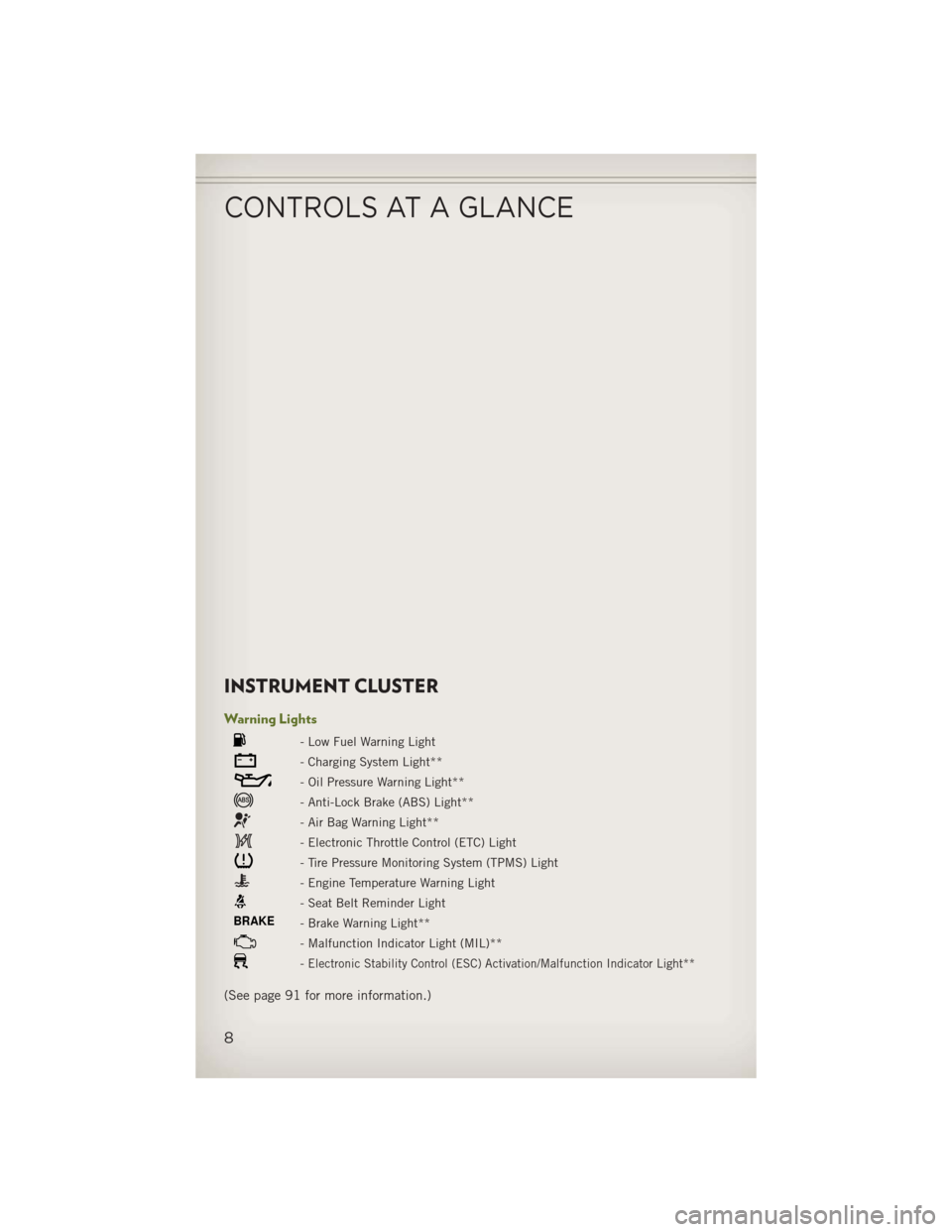
INSTRUMENT CLUSTER
Warning Lights
- Low Fuel Warning Light
- Charging System Light**
- Oil Pressure Warning Light**
- Anti-Lock Brake (ABS) Light**
- Air Bag Warning Light**
- Electronic Throttle Control (ETC) Light
- Tire Pressure Monitoring System (TPMS) Light
- Engine Temperature Warning Light
- Seat Belt Reminder Light
BRAKE- Brake Warning Light**
- Malfunction Indicator Light (MIL)**
-Electronic Stability Control (ESC) Activation/Malfunction Indicator Light**
(See page 91 for more information.)
CONTROLS AT A GLANCE
8
Page 11 of 132
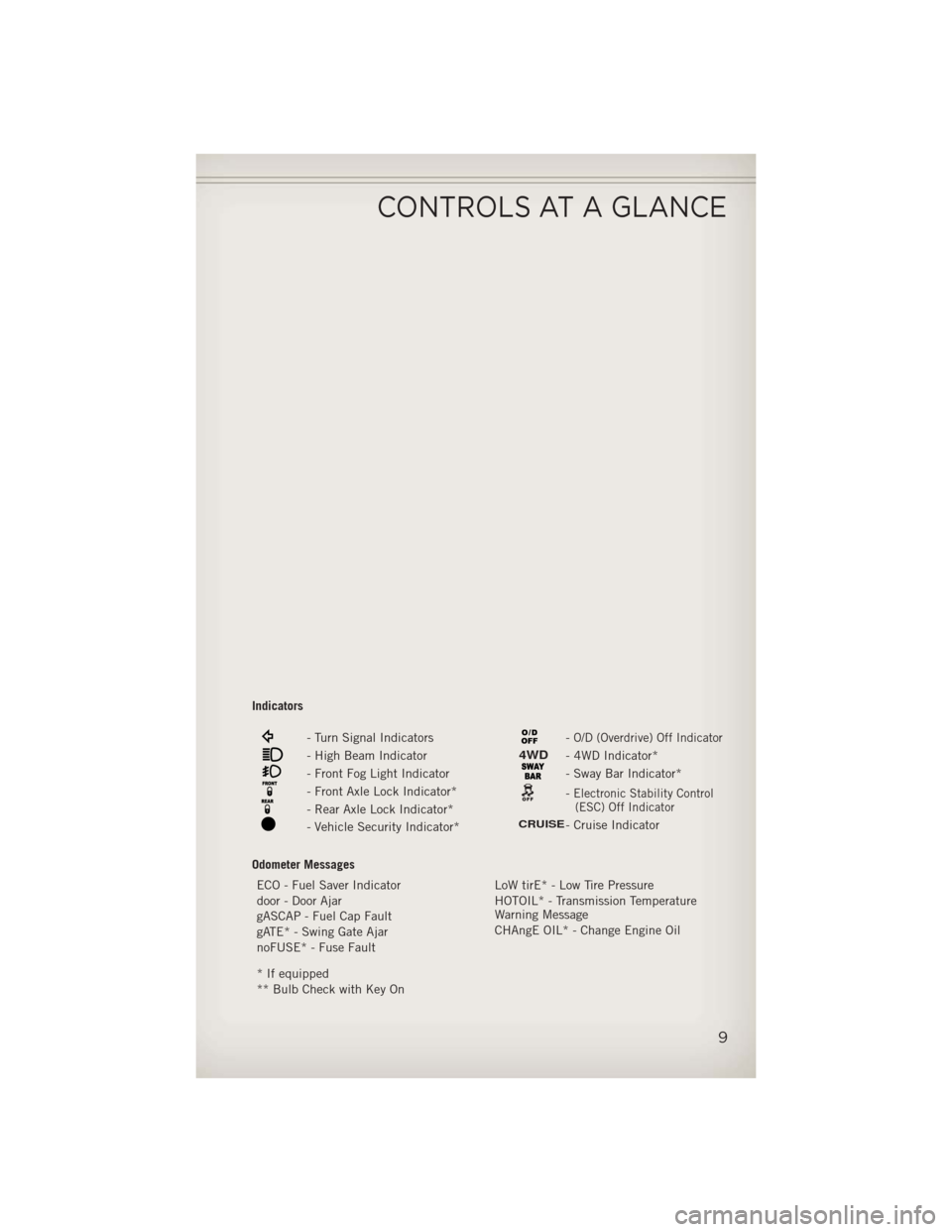
Indicators
- Turn Signal Indicators
- High Beam Indicator
- Front Fog Light Indicator
- Front Axle Lock Indicator*
- Rear Axle Lock Indicator*
- Vehicle Security Indicator*
-O/D (Overdrive) Off Indicator
4WD- 4WD Indicator*
- Sway Bar Indicator*
-Electronic Stability Control(ESC) Off Indicator
CRUISE- Cruise Indicator
Odometer Messages ECO - Fuel Saver Indicator LoW tirE* - Low Tire Pressure
door - Door Ajar HOTOIL* - Transmission Temperature
Warning Message
gASCAP - Fuel Cap Fault
CHAngE OIL* - Change Engine Oil
gATE* - Swing Gate Ajar
noFUSE* - Fuse Fault
* If equipped
** Bulb Check with Key On
CONTROLS AT A GLANCE
9
Page 22 of 132
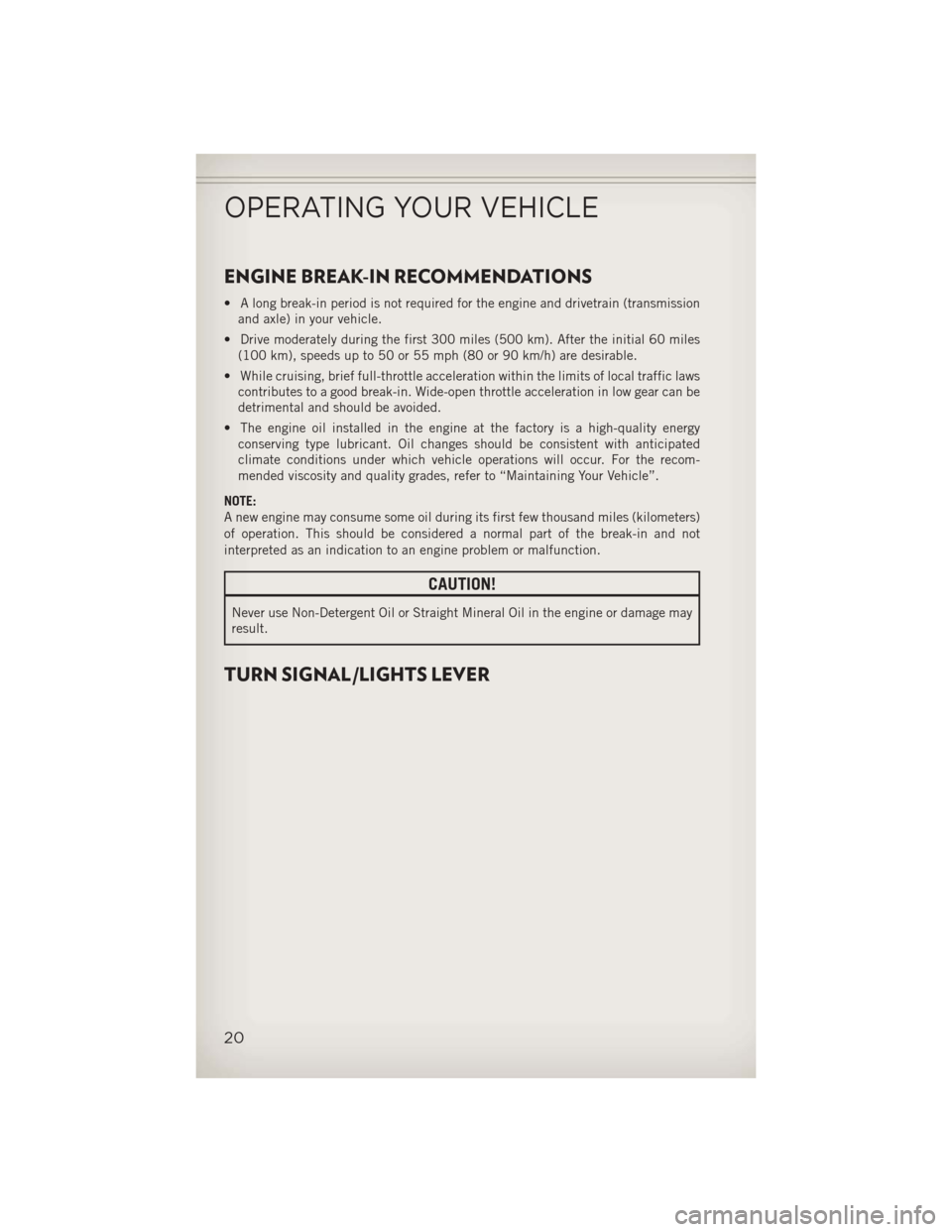
ENGINE BREAK-IN RECOMMENDATIONS
• A long break-in period is not required for the engine and drivetrain (transmissionand axle) in your vehicle.
• Drive moderately during the first 300 miles (500 km). After the initial 60 miles (100 km), speeds up to 50 or 55 mph (80 or 90 km/h) are desirable.
• While cruising, brief full-throttle acceleration within the limits of local traffic laws contributes to a good break-in. Wide-open throttle acceleration in low gear can be
detrimental and should be avoided.
• The engine oil installed in the engine at the factory is a high-quality energy conserving type lubricant. Oil changes should be consistent with anticipated
climate conditions under which vehicle operations will occur. For the recom-
mended viscosity and quality grades, refer to “Maintaining Your Vehicle”.
NOTE:
A new engine may consume some oil during its first few thousand miles (kilometers)
of operation. This should be considered a normal part of the break-in and not
interpreted as an indication to an engine problem or malfunction.
CAUTION!
Never use Non-Detergent Oil or Straight Mineral Oil in the engine or damage may
result.
TURN SIGNAL/LIGHTS LEVER
OPERATING YOUR VEHICLE
20
Page 95 of 132
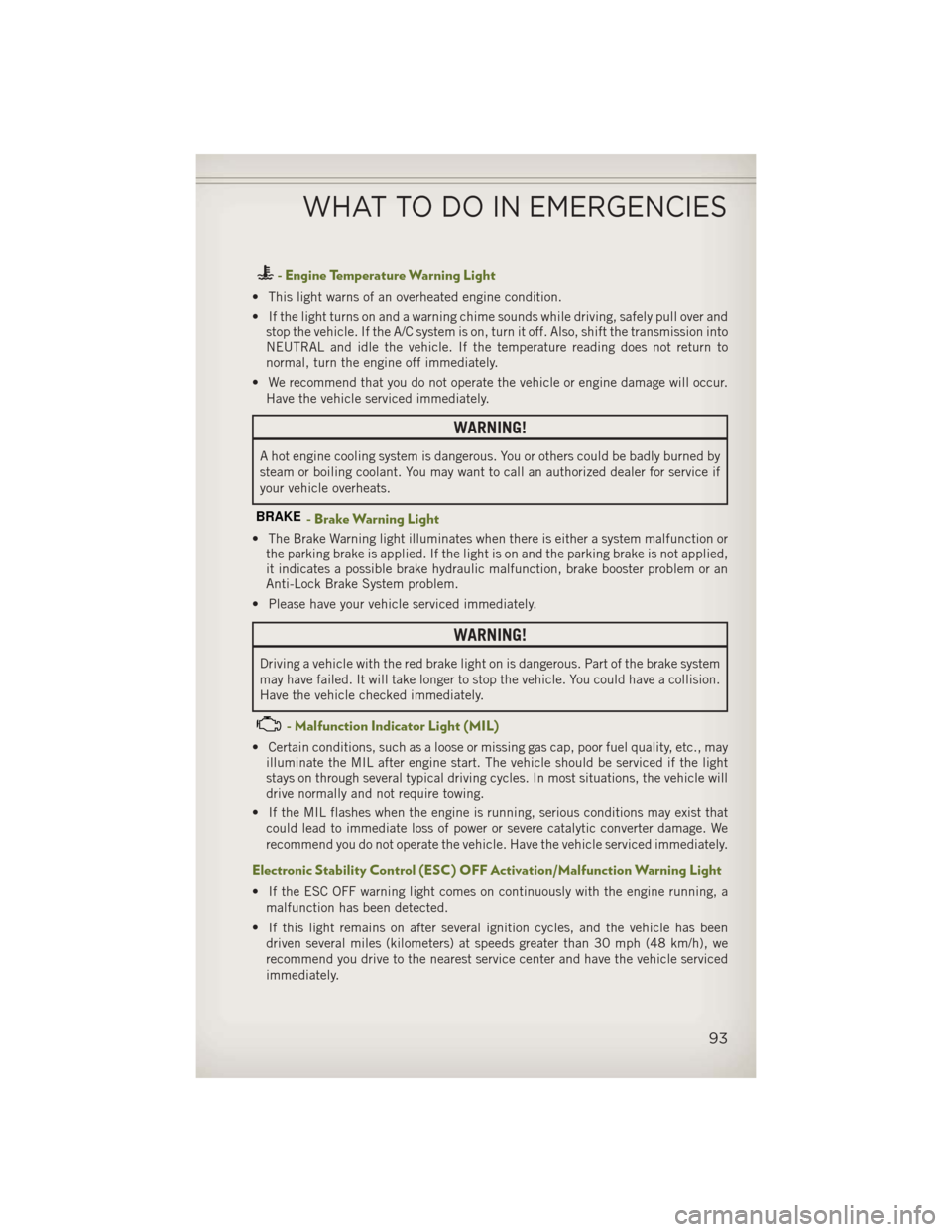
- Engine Temperature Warning Light
• This light warns of an overheated engine condition.
• If the light turns on and a warning chime sounds while driving, safely pull over andstop the vehicle. If the A/C system is on, turn it off. Also, shift the transmission into
NEUTRAL and idle the vehicle. If the temperature reading does not return to
normal, turn the engine off immediately.
• We recommend that you do not operate the vehicle or engine damage will occur. Have the vehicle serviced immediately.
WARNING!
A hot engine cooling system is dangerous. You or others could be badly burned by
steam or boiling coolant. You may want to call an authorized dealer for service if
your vehicle overheats.
BRAKE- Brake Warning Light
• The Brake Warning light illuminates when there is either a system malfunction orthe parking brake is applied. If the light is on and the parking brake is not applied,
it indicates a possible brake hydraulic malfunction, brake booster problem or an
Anti-Lock Brake System problem.
• Please have your vehicle serviced immediately.
WARNING!
Driving a vehicle with the red brake light on is dangerous. Part of the brake system
may have failed. It will take longer to stop the vehicle. You could have a collision.
Have the vehicle checked immediately.
- Malfunction Indicator Light (MIL)
• Certain conditions, such as a loose or missing gas cap, poor fuel quality, etc., may illuminate the MIL after engine start. The vehicle should be serviced if the light
stays on through several typical driving cycles. In most situations, the vehicle will
drive normally and not require towing.
• If the MIL flashes when the engine is running, serious conditions may exist that could lead to immediate loss of power or severe catalytic converter damage. We
recommend you do not operate the vehicle. Have the vehicle serviced immediately.
Electronic Stability Control (ESC) OFF Activation/Malfunction Warning Light
• If the ESC OFF warning light comes on continuously with the engine running, amalfunction has been detected.
• If this light remains on after several ignition cycles, and the vehicle has been driven several miles (kilometers) at speeds greater than 30 mph (48 km/h), we
recommend you drive to the nearest service center and have the vehicle serviced
immediately.
WHAT TO DO IN EMERGENCIES
93
Page 96 of 132
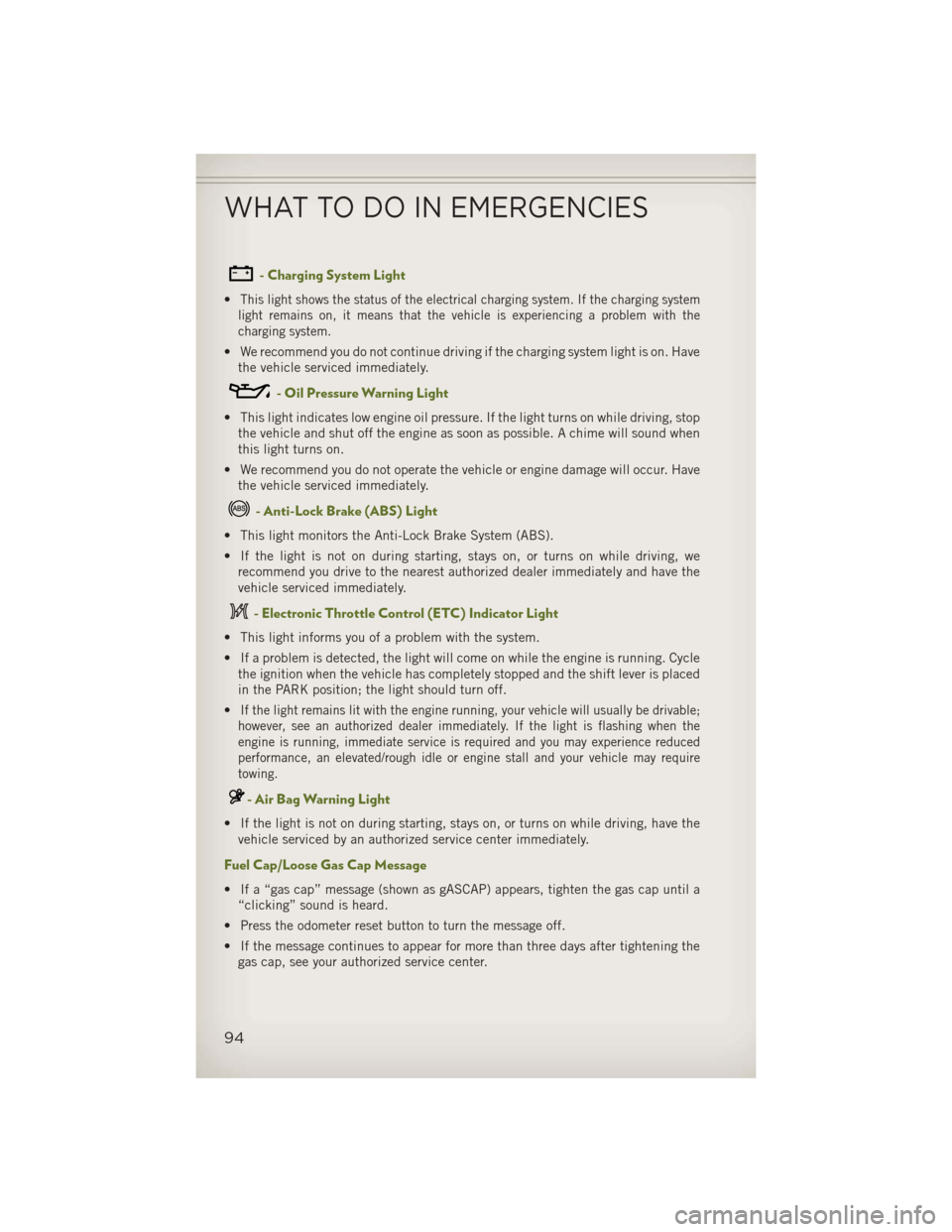
- Charging System Light
•This light shows the status of the electrical charging system. If the charging system
light remains on, it means that the vehicle is experiencing a problem with the
charging system.
• We recommend you do not continue driving if the charging system light is on. Have the vehicle serviced immediately.
- Oil Pressure Warning Light
• This light indicates low engine oil pressure. If the light turns on while driving, stopthe vehicle and shut off the engine as soon as possible. A chime will sound when
this light turns on.
• We recommend you do not operate the vehicle or engine damage will occur. Have the vehicle serviced immediately.
- Anti-Lock Brake (ABS) Light
• This light monitors the Anti-Lock Brake System (ABS).
• If the light is not on during starting, stays on, or turns on while driving, werecommend you drive to the nearest authorized dealer immediately and have the
vehicle serviced immediately.
- Electronic Throttle Control (ETC) Indicator Light
• This light informs you of a problem with the system.
• If a problem is detected, the light will come on while the engine is running. Cyclethe ignition when the vehicle has completely stopped and the shift lever is placed
in the PARK position; the light should turn off.
•
If the light remains lit with the engine running, your vehicle will usually be drivable;
however, see an authorized dealer immediately. If the light is flashing when the
engine is running, immediate service is required and you may experience reduced
performance, an elevated/rough idle or engine stall and your vehicle may require
towing.
- Air Bag Warning Light
• If the light is not on during starting, stays on, or turns on while driving, have the vehicle serviced by an authorized service center immediately.
Fuel Cap/Loose Gas Cap Message
• If a “gas cap” message (shown as gASCAP) appears, tighten the gas cap until a“clicking” sound is heard.
• Press the odometer reset button to turn the message off.
• If the message continues to appear for more than three days after tightening the gas cap, see your authorized service center.
WHAT TO DO IN EMERGENCIES
94
Page 97 of 132
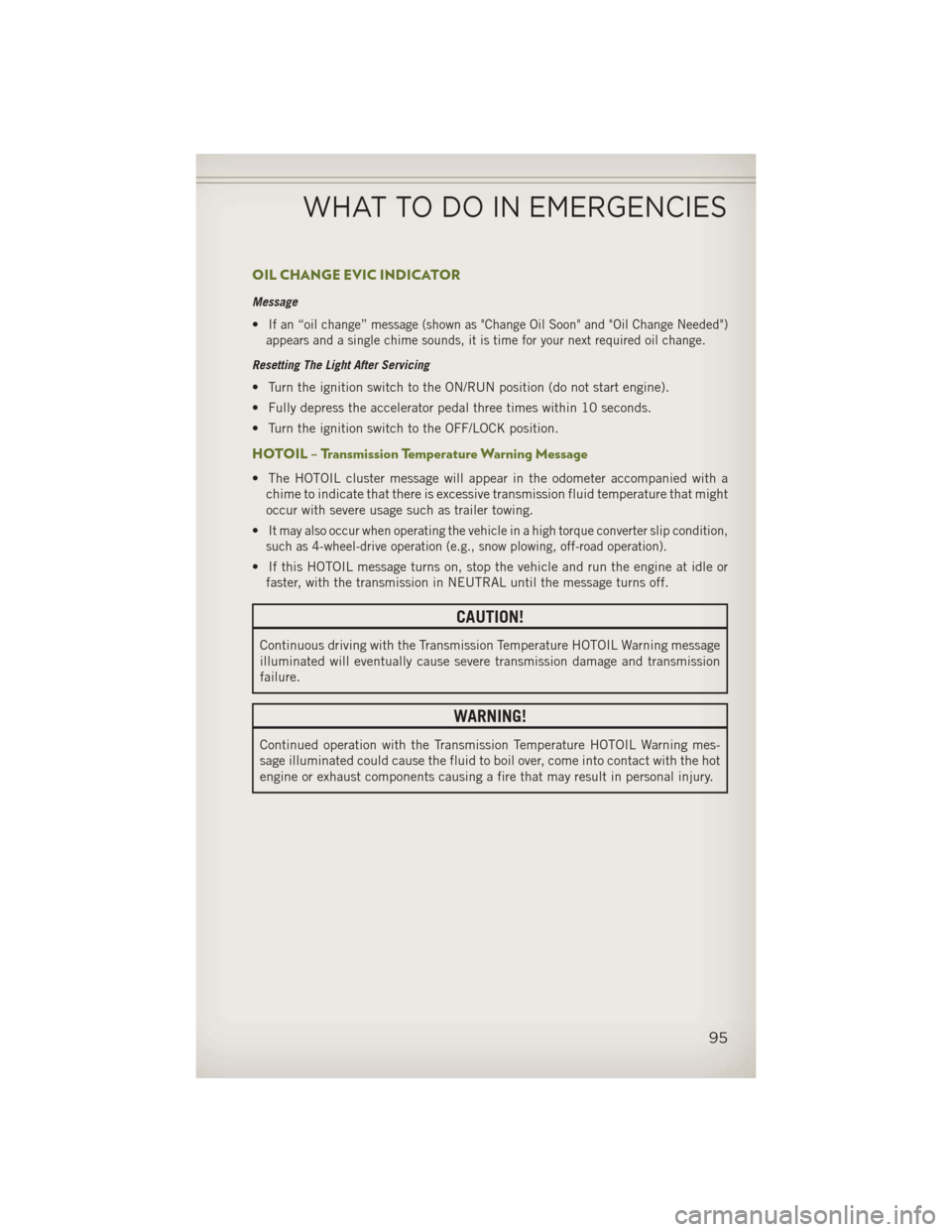
OIL CHANGE EVIC INDICATOR
Message
•If an “oil change” message (shown as "Change Oil Soon" and "Oil Change Needed")
appears and a single chime sounds, it is time for your next required oil change.
Resetting The Light After Servicing
• Turn the ignition switch to the ON/RUN position (do not start engine).
• Fully depress the accelerator pedal three times within 10 seconds.
• Turn the ignition switch to the OFF/LOCK position.
HOTOIL – Transmission Temperature Warning Message
• The HOTOIL cluster message will appear in the odometer accompanied with a chime to indicate that there is excessive transmission fluid temperature that might
occur with severe usage such as trailer towing.
•
It may also occur when operating the vehicle in a high torque converter slip condition,
such as 4-wheel-drive operation (e.g., snow plowing, off-road operation).
• If this HOTOIL message turns on, stop the vehicle and run the engine at idle or faster, with the transmission in NEUTRAL until the message turns off.
CAUTION!
Continuous driving with the Transmission Temperature HOTOIL Warning message
illuminated will eventually cause severe transmission damage and transmission
failure.
WARNING!
Continued operation with the Transmission Temperature HOTOIL Warning mes-
sage illuminated could cause the fluid to boil over, come into contact with the hot
engine or exhaust components causing a fire that may result in personal injury.
WHAT TO DO IN EMERGENCIES
95
Page 110 of 132
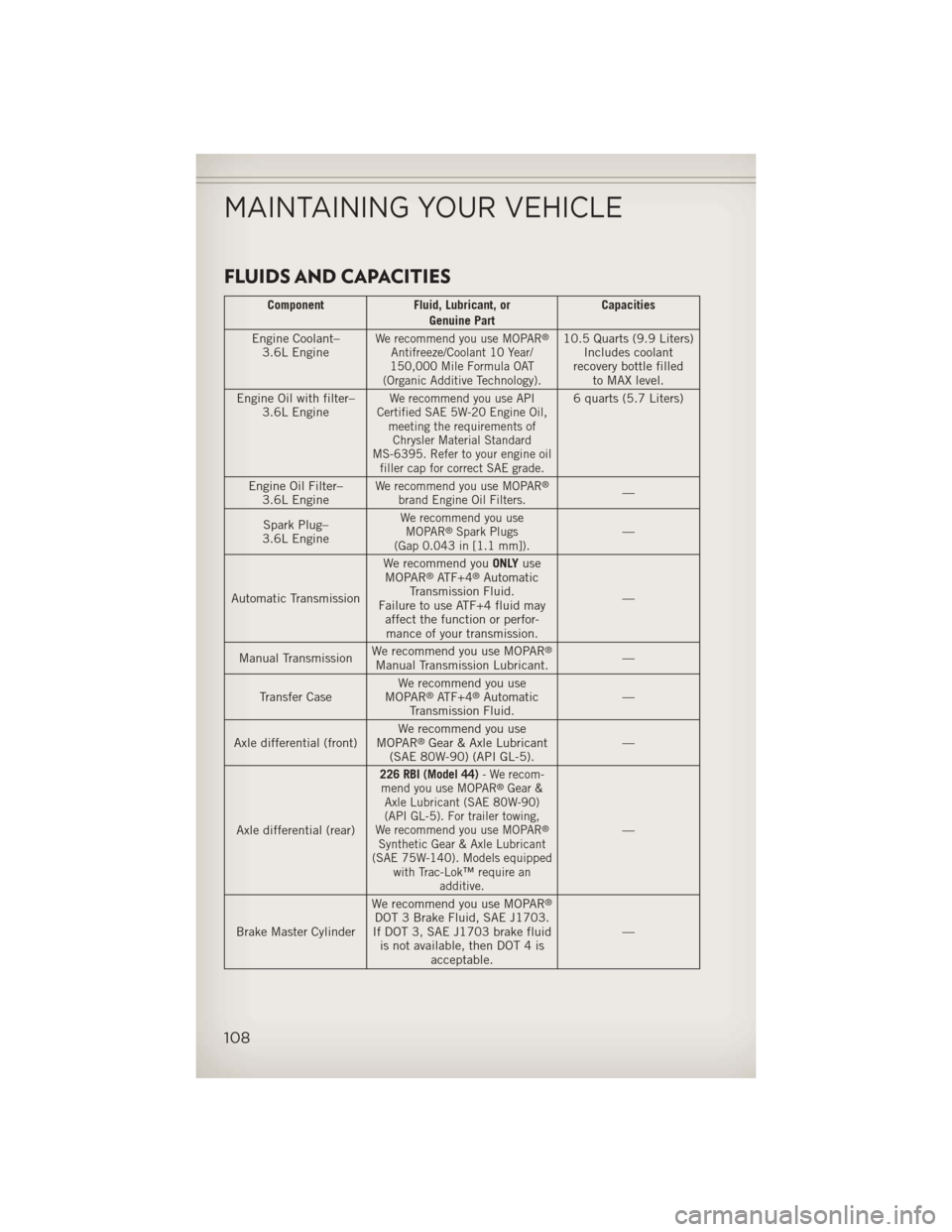
FLUIDS AND CAPACITIES
ComponentFluid, Lubricant, or
Genuine Part Capacities
Engine Coolant– 3.6L Engine
We recommend you use MOPAR®
Antifreeze/Coolant 10 Year/
150,000 Mile Formula OAT
(Organic Additive Technology).10.5 Quarts (9.9 Liters) Includes coolant
recovery bottle filled to MAX level.
Engine Oil with filter– 3.6L Engine
We recommend you use API
Certified SAE 5W-20 Engine Oil, meeting the requirements ofChrysler Material Standard
MS-6395. Refer to your engine oil filler cap for correct SAE grade.6 quarts (5.7 Liters)
Engine Oil Filter– 3.6L Engine
We recommend you use MOPAR®
brand Engine Oil Filters.—
Spark Plug–
3.6L Engine
We recommend you use MOPAR®Spark Plugs
(Gap 0.043 in [1.1 mm]).—
Automatic Transmission We recommend you
ONLYuse
MOPAR
®ATF+4®Automatic
Transmission Fluid.
Failure to use ATF+4 fluid may affect the function or perfor-mance of your transmission. —
Manual Transmission We recommend you use MOPAR
®
Manual Transmission Lubricant. —
Transfer Case We recommend you use
MOPAR
®ATF+4®Automatic
Transmission Fluid. —
Axle differential (front) We recommend you use
MOPAR
®Gear & Axle Lubricant
(SAE 80W-90) (API GL-5). —
Axle differential (rear)
226 RBI (Model 44) - We recom-
mend you use MOPAR®Gear &
Axle Lubricant (SAE 80W-90)
(API GL-5). For trailer towing,
We recommend you use MOPAR
®
Synthetic Gear & Axle Lubricant
(SAE 75W-140). Models equipped with Trac-Lok™ require an additive.—
Brake Master Cylinder We recommend you use MOPAR
®
DOT 3 Brake Fluid, SAE J1703.
If DOT 3, SAE J1703 brake fluid is not available, then DOT 4 is acceptable. —
MAINTAINING YOUR VEHICLE
108
Page 112 of 132
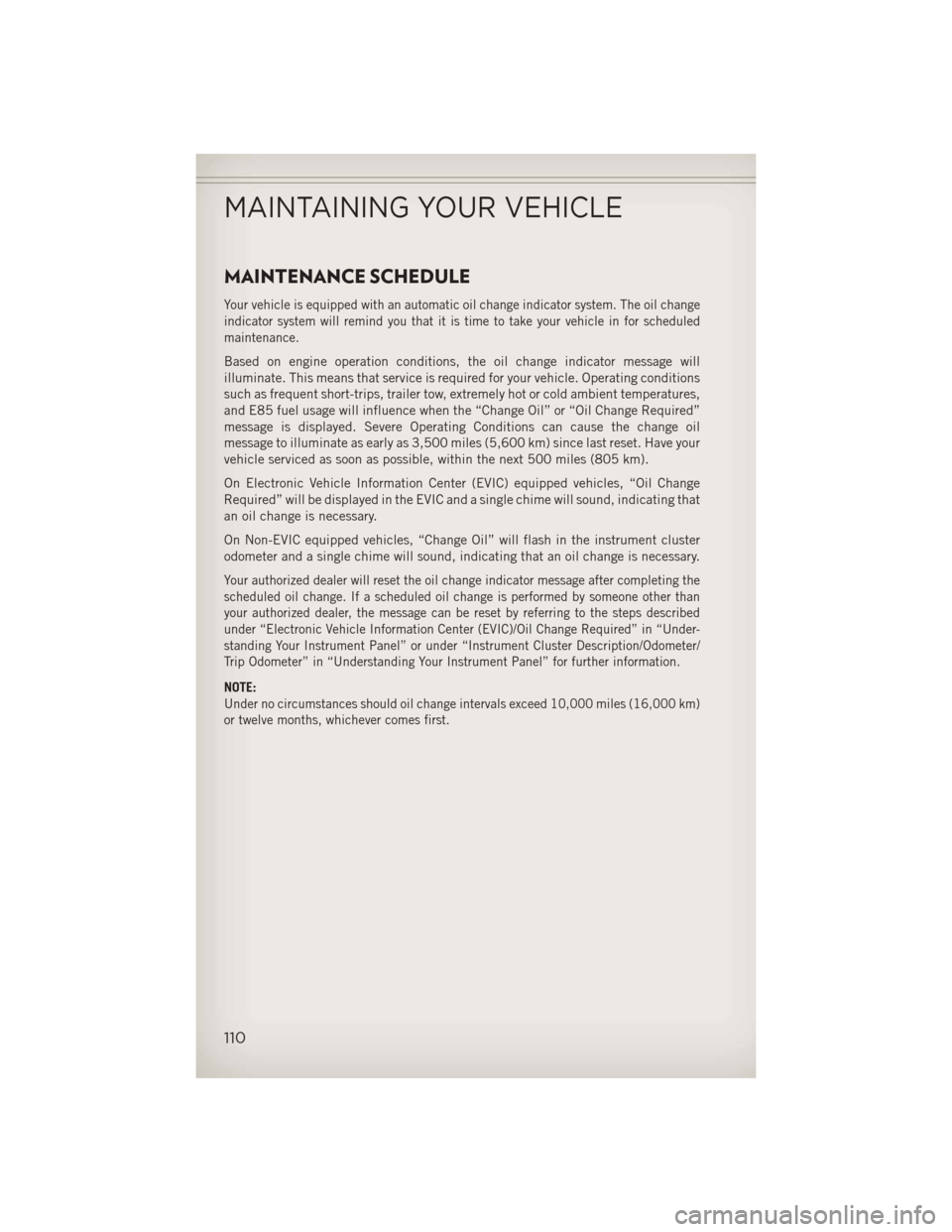
MAINTENANCE SCHEDULE
Your vehicle is equipped with an automatic oil change indicator system. The oil change
indicator system will remind you that it is time to take your vehicle in for scheduled
maintenance.
Based on engine operation conditions, the oil change indicator message will
illuminate. This means that service is required for your vehicle. Operating conditions
such as frequent short-trips, trailer tow, extremely hot or cold ambient temperatures,
and E85 fuel usage will influence when the “Change Oil” or “Oil Change Required”
message is displayed. Severe Operating Conditions can cause the change oil
message to illuminate as early as 3,500 miles (5,600 km) since last reset. Have your
vehicle serviced as soon as possible, within the next 500 miles (805 km).
On Electronic Vehicle Information Center (EVIC) equipped vehicles, “Oil Change
Required” will be displayed in the EVIC and a single chime will sound, indicating that
an oil change is necessary.
On Non-EVIC equipped vehicles, “Change Oil” will flash in the instrument cluster
odometer and a single chime will sound, indicating that an oil change is necessary.
Your authorized dealer will reset the oil change indicator message after completing the
scheduled oil change. If a scheduled oil change is performed by someone other than
your authorized dealer, the message can be reset by referring to the steps described
under “Electronic Vehicle Information Center (EVIC)/Oil Change Required” in “Under-
standing Your Instrument Panel” or under “Instrument Cluster Description/Odometer/
Trip Odometer” in “Understanding Your Instrument Panel” for further information.
NOTE:
Under no circumstances should oil change intervals exceed 10,000 miles (16,000 km)
or twelve months, whichever comes first.
MAINTAINING YOUR VEHICLE
110
Page 113 of 132
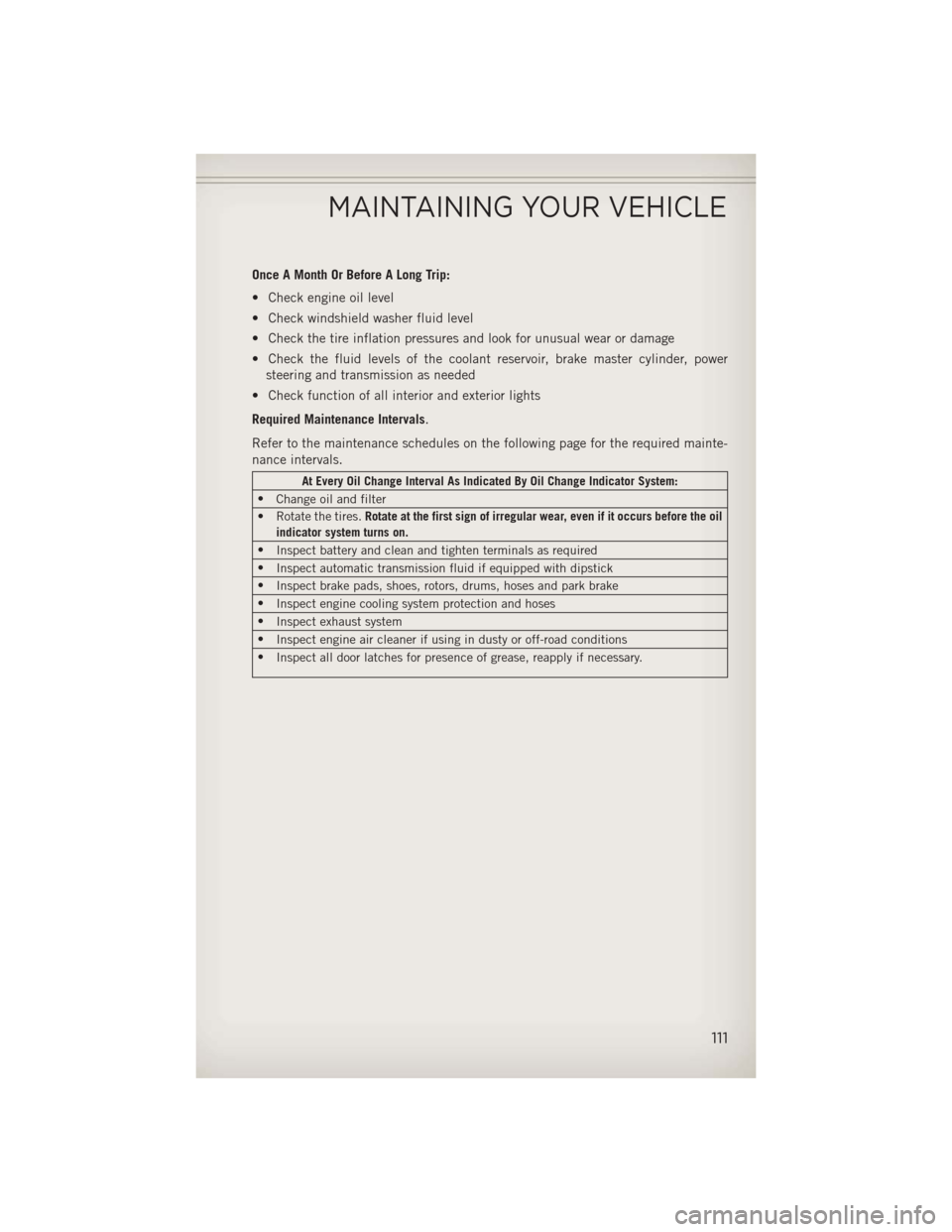
Once A Month Or Before A Long Trip:
• Check engine oil level
• Check windshield washer fluid level
• Check the tire inflation pressures and look for unusual wear or damage
• Check the fluid levels of the coolant reservoir, brake master cylinder, powersteering and transmission as needed
• Check function of all interior and exterior lights
Required Maintenance Intervals.
Refer to the maintenance schedules on the following page for the required mainte-
nance intervals.
At Every Oil Change Interval As Indicated By Oil Change Indicator System:
• Change oil and filter
• Rotate the tires. Rotate at the first sign of irregular wear, even if it occurs before the oil
indicator system turns on.
• Inspect battery and clean and tighten terminals as required
• Inspect automatic transmission fluid if equipped with dipstick
• Inspect brake pads, shoes, rotors, drums, hoses and park brake
• Inspect engine cooling system protection and hoses
• Inspect exhaust system
• Inspect engine air cleaner if using in dusty or off-road conditions
• Inspect all door latches for presence of grease, reapply if necessary.
MAINTAINING YOUR VEHICLE
111
Page 126 of 132
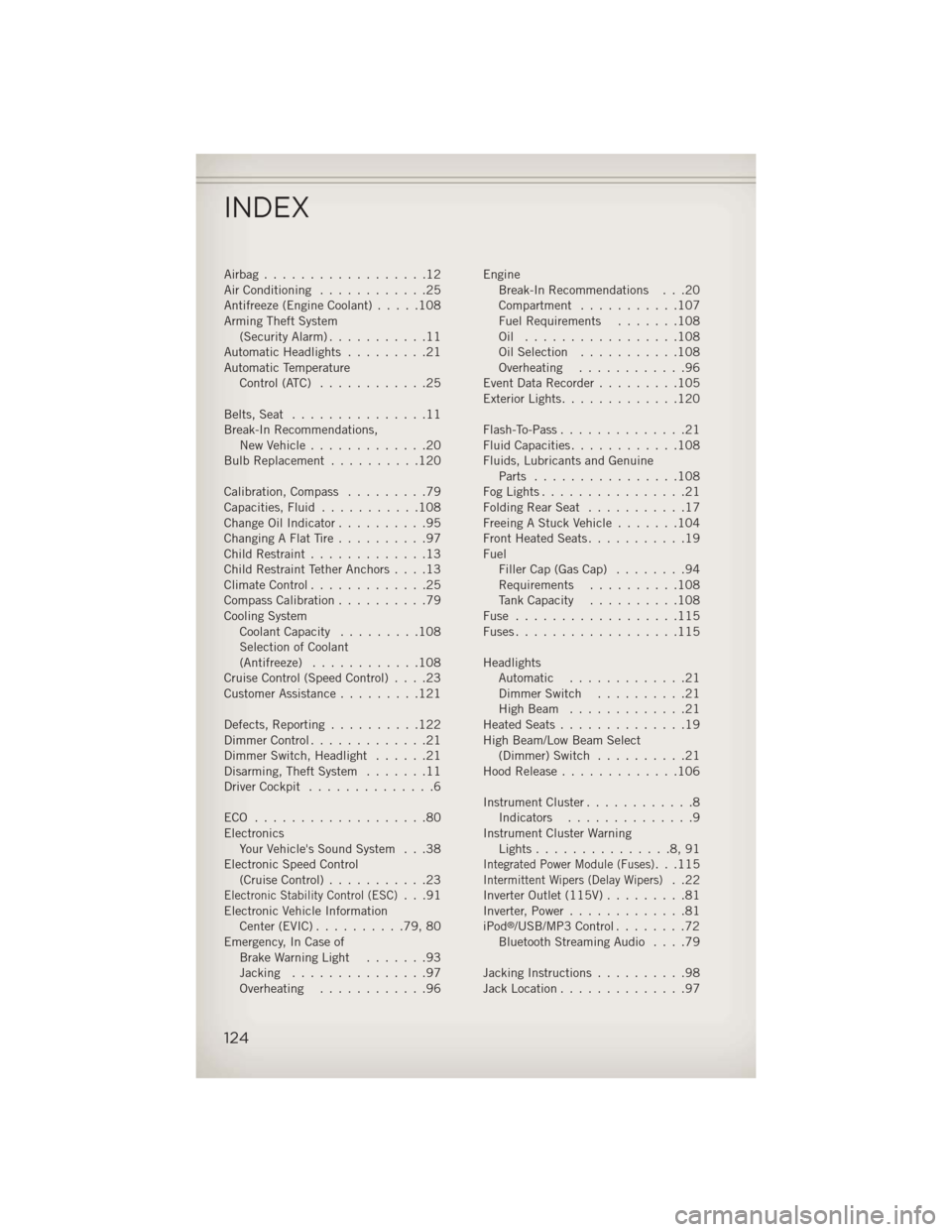
Airbag..................12
Air Conditioning............25
Antifreeze (Engine Coolant) .....108
Arming Theft System (Security Alarm) ...........11
Automatic Headlights .........21
Automatic Temperature Control (ATC) ............25
Belts, Seat ...............11
Break-In Recommendations, New Vehicle .............20
Bulb Replacement ..........120
Calibration, Compass .........79
Capacities, Fluid ...........108
Change Oil Indicator ..........95
Changing A Flat Tire ..........97
Child Restraint .............13
Child Restraint Tether Anchors ....13
ClimateControl.............25
Compass Calibration ..........79
Cooling System Coolant Capacity .........108
Selection of Coolant
(Antifreeze) ............108
Cruise Control (Speed Control) ....23
Customer Assistance .........121
Defects, Reporting ..........122
Dimmer Control .............21
Dimmer Switch, Headlight ......21
Disarming, Theft System .......11
Driver Cockpit ..............6
ECO ...................80
Electronics Your Vehicle's Sound System . . .38
Electronic Speed Control (Cruise Control) ...........23
Electronic Stability Control (ESC)...91
Electronic Vehicle Information Center(EVIC)..........79,80
Emergency, In Case of Brake Warning Light .......93
Jacking ...............97
Overheating ............96 Engine
Break-In Recommendations . . .20
Compartment ...........107
Fuel Requirements .......108
Oil .................108
Oil Selection ...........108
Overheating ............96
Event Data Recorder .........105
Exterior Lights .............120
Flash-To-Pass ..............21
Fluid Capacities ............108
Fluids, Lubricants and Genuine Parts ................108
FogLights................21
FoldingRearSeat ...........17
Freeing A Stuck Vehicle .......104
Front Heated Seats ...........19
Fuel Filler Cap (Gas Cap) ........94
Requirements ..........108
Tank Capacity ..........108
Fuse ..................115
Fuses..................115
Headlights Automatic .............21
Dimmer Switch ..........21
HighBeam .............21
Heated Seats ..............19
High Beam/Low Beam Select (Dimmer) Switch ..........21
Hood Release .............106
Instrument Cluster ............8
Indicators ..............9
Instrument Cluster Warning Lights...............8,91
Integrated Power Module (Fuses)...115Intermittent Wipers (Delay Wipers)..22
Inverter Outlet (115V) .........81
Inverter, Power .............81
iPod
®/USB/MP3 Control ........72
Bluetooth Streaming Audio ....79
Jacking Instructions ..........98
Jack Location ..............97
INDEX
124